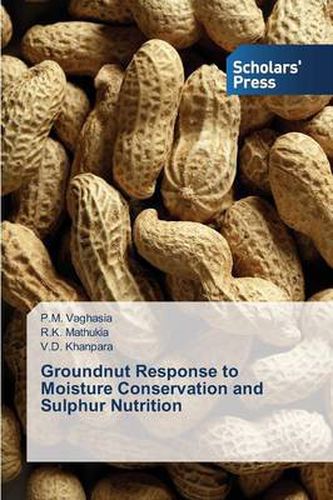Readings Newsletter
Become a Readings Member to make your shopping experience even easier.
Sign in or sign up for free!
You’re not far away from qualifying for FREE standard shipping within Australia
You’ve qualified for FREE standard shipping within Australia
The cart is loading…






This title is printed to order. This book may have been self-published. If so, we cannot guarantee the quality of the content. In the main most books will have gone through the editing process however some may not. We therefore suggest that you be aware of this before ordering this book. If in doubt check either the author or publisher’s details as we are unable to accept any returns unless they are faulty. Please contact us if you have any questions.
About 88 per cent of groundnut area in India is sown in the kharif season and is rainfed. Water is the most vital resource in crop production especially in arid and semi arid regions. Rain water conservation is a critical factor in stabilizing and stepping up of rainfed groundnut production. A tillage practice like subsoiling and land configuration like broad bed and furrow improve infiltration of rain water and thus helps to improve moisture storage in soil profile for plants growth than the traditional method of flat bed. Besides, soil conservation practices, sulphur nutrition for oilseed crops in general and for groundnut crop in particular is one of the important pre-requisites for enhancing productivity and quality of groundnut. Sulphur as a plant nutrient is becoming increasingly important in dryland agriculture as it is the master nutrient of all oilseed crops and pulses and is rightly being called the Forth Major Nutrient . One of the reasons for low productivity of groundnut in drylands are low soil moisture and fertility, which can be increased by tillage management practices and proper nutrient management particularly sulphur.
$9.00 standard shipping within Australia
FREE standard shipping within Australia for orders over $100.00
Express & International shipping calculated at checkout
Stock availability can be subject to change without notice. We recommend calling the shop or contacting our online team to check availability of low stock items. Please see our Shopping Online page for more details.
This title is printed to order. This book may have been self-published. If so, we cannot guarantee the quality of the content. In the main most books will have gone through the editing process however some may not. We therefore suggest that you be aware of this before ordering this book. If in doubt check either the author or publisher’s details as we are unable to accept any returns unless they are faulty. Please contact us if you have any questions.
About 88 per cent of groundnut area in India is sown in the kharif season and is rainfed. Water is the most vital resource in crop production especially in arid and semi arid regions. Rain water conservation is a critical factor in stabilizing and stepping up of rainfed groundnut production. A tillage practice like subsoiling and land configuration like broad bed and furrow improve infiltration of rain water and thus helps to improve moisture storage in soil profile for plants growth than the traditional method of flat bed. Besides, soil conservation practices, sulphur nutrition for oilseed crops in general and for groundnut crop in particular is one of the important pre-requisites for enhancing productivity and quality of groundnut. Sulphur as a plant nutrient is becoming increasingly important in dryland agriculture as it is the master nutrient of all oilseed crops and pulses and is rightly being called the Forth Major Nutrient . One of the reasons for low productivity of groundnut in drylands are low soil moisture and fertility, which can be increased by tillage management practices and proper nutrient management particularly sulphur.